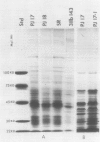Abstract
Rates of respiratory CO2 loss and nitrogenase activities of H2 uptake-negative mutant strains and H2 uptake-positive revertant strains of Rhizobium japonicum have been investigated. Two-dimensional gel protein patterns of bacteroids formed by inoculation of soybeans (Glycine max L.) with these two strains show that they are closely related and revealed only one obvious difference between them. On the basis of molecular weight standards, it was concluded that the missing protein spot in the H2 uptake-negative mutant strain could be caused by a failure of the mutant to synthesize hydrogenase. Nodules formed by the H2 uptake-negative mutant strain evolved respiratory CO2 at a rate of about 10% higher than that of nodules formed by the H2 uptake-positive revertant strain. During short-term experiments employed, rates of both C2H2 reduction and 15N2 fixation varied considerably among replicate samples and no statistically significant differences between mutant and revertant strains were observed. It was observed that increasing the partial pressure of O2 over nodules significantly decreased the proportion of nitrogenase electrons allocated to H+.
Full text
PDF
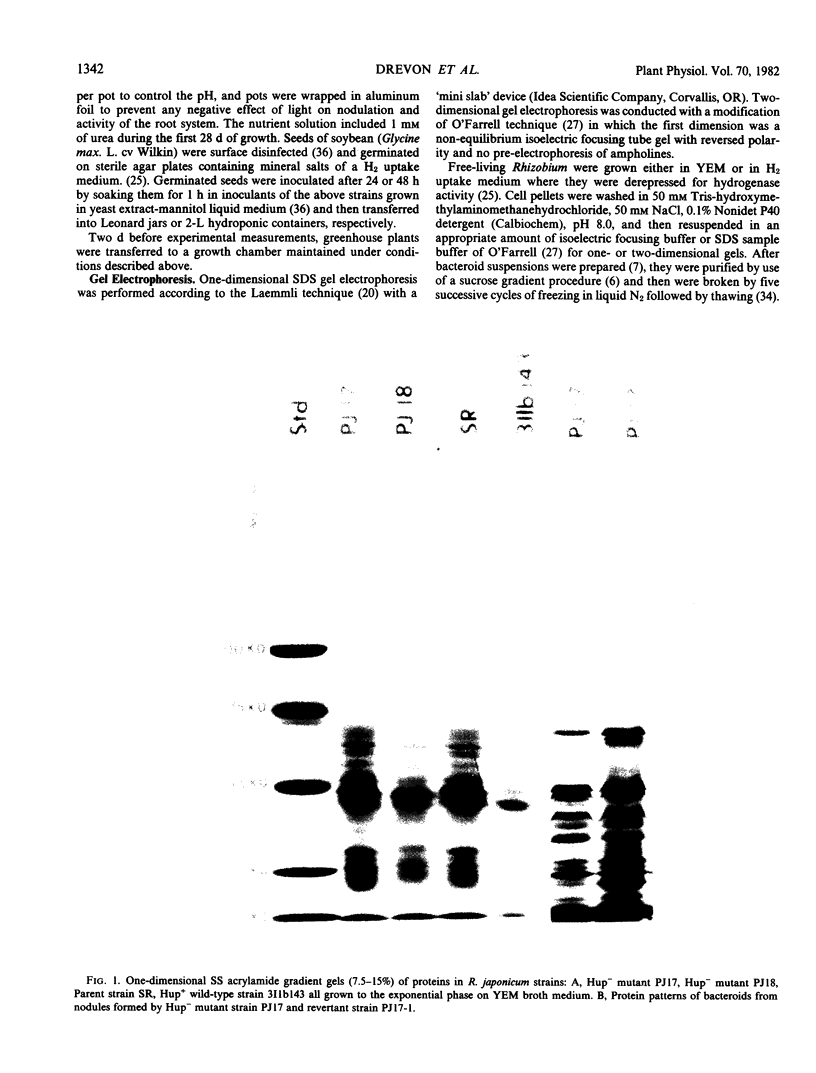
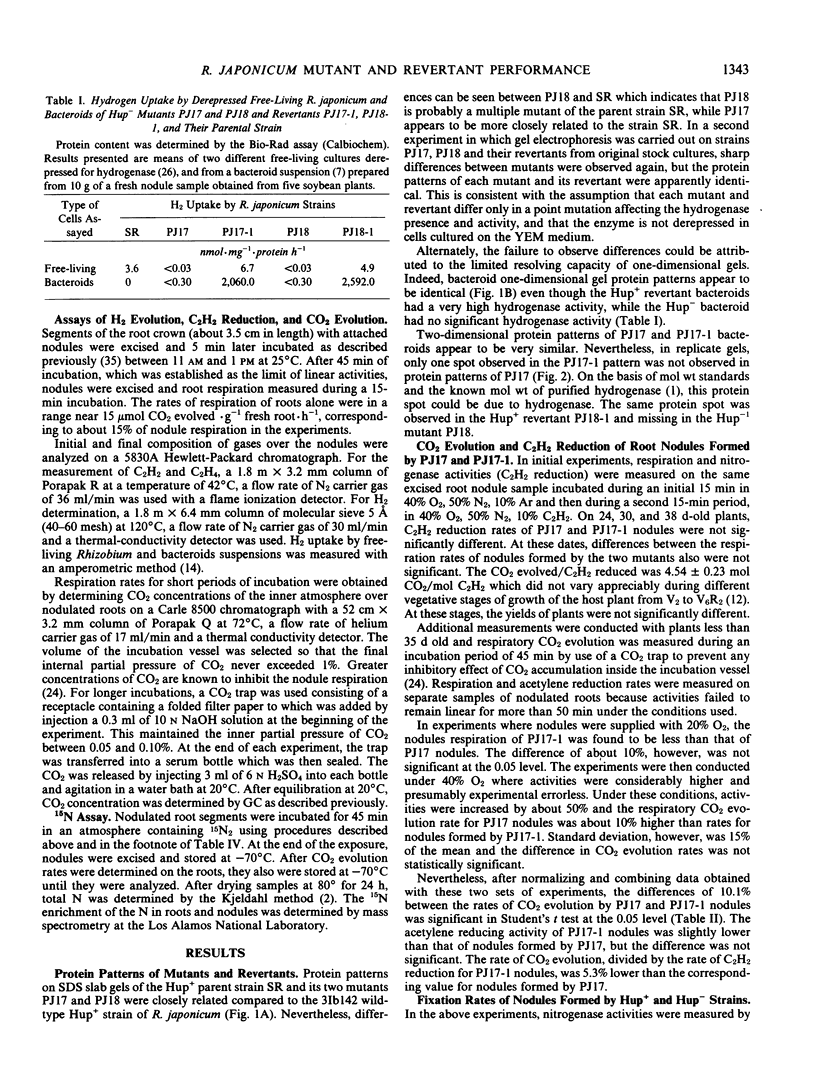
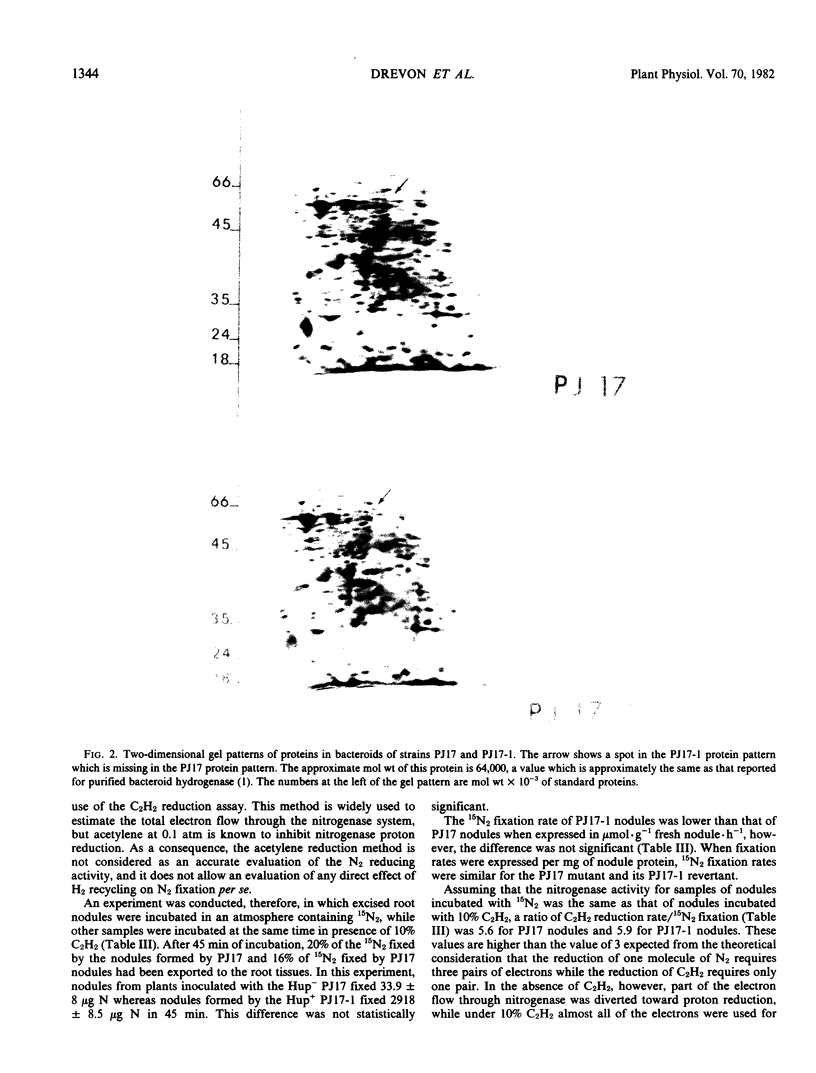
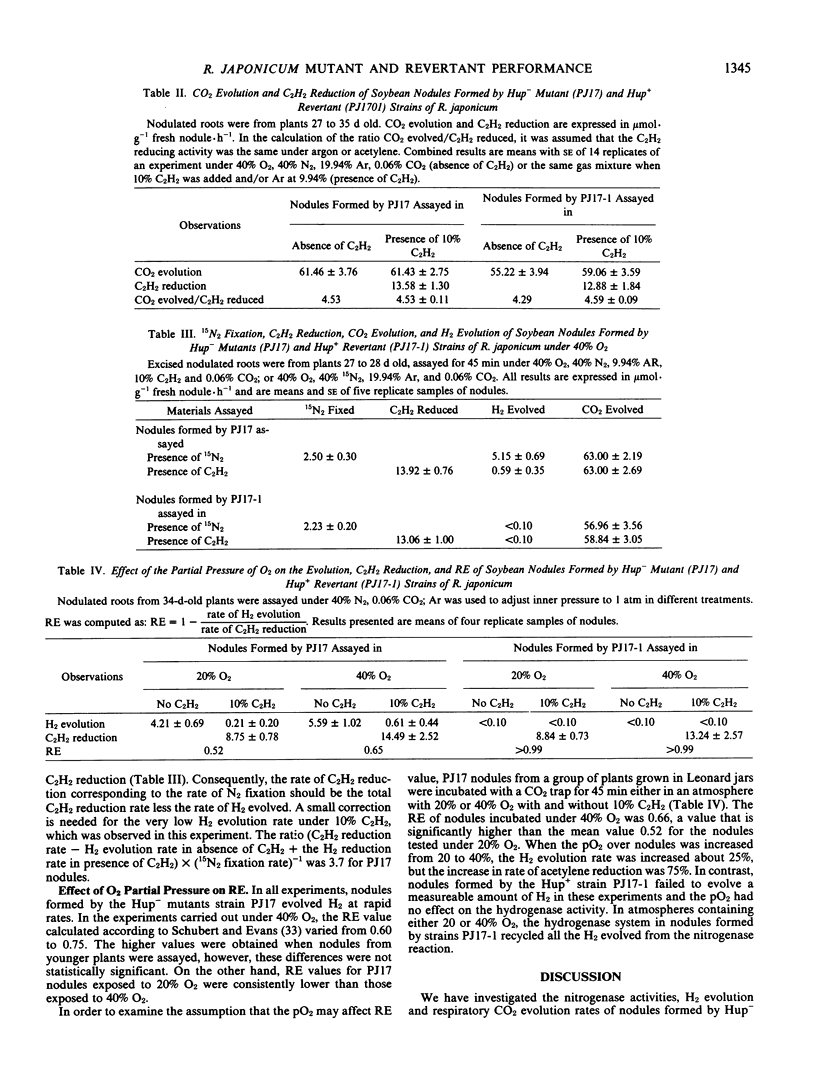
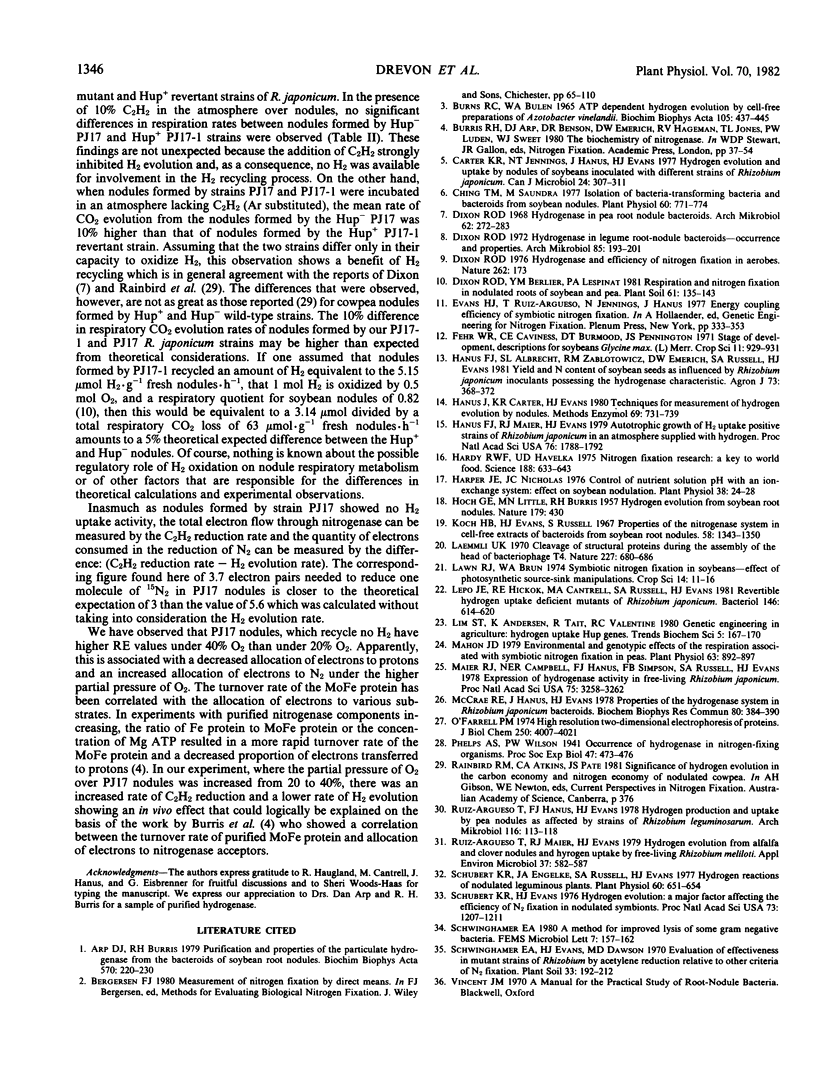
Images in this article
Selected References
These references are in PubMed. This may not be the complete list of references from this article.
- Arp D. J., Burris R. H. Purification and properties of the particulate hydrogenase from the bacteroids of soybean root nodules. Biochim Biophys Acta. 1979 Oct 11;570(2):221–230. doi: 10.1016/0005-2744(79)90142-6. [DOI] [PubMed] [Google Scholar]
- Burns R. C., Bulen W. A. ATP-dependent hydrogen evolution by cell-free preparations of Azotobacter vinelandii. Biochim Biophys Acta. 1965 Sep 20;105(3):437–445. doi: 10.1016/s0926-6593(65)80229-6. [DOI] [PubMed] [Google Scholar]
- Carter K. R., Jennings N. T., Hanus J., Evans H. J. Hydrogen evolution and uptake by nodules of soybeans inoculated with different strains of Rhizobium japonicum. Can J Microbiol. 1978 Mar;24(3):307–311. doi: 10.1139/m78-051. [DOI] [PubMed] [Google Scholar]
- Ching T. M., Hedtke S. Isolation of bacteria, transforming bacteria, and bacteroids from soybean nodules. Plant Physiol. 1977 Nov;60(5):771–774. doi: 10.1104/pp.60.5.771. [DOI] [PMC free article] [PubMed] [Google Scholar]
- Dixon R. O. Hydrogenase in legume root nodule bacteroids: occurrence and properties. Arch Mikrobiol. 1972;85(3):193–201. doi: 10.1007/BF00408844. [DOI] [PubMed] [Google Scholar]
- Dixon R. O. Hydrogenase in pea root nodule bacterioids. Arch Mikrobiol. 1968;62(3):272–283. doi: 10.1007/BF00413898. [DOI] [PubMed] [Google Scholar]
- Evans H. J., Ruiz-Argüeso T., Jennings N., Hanus J. Energy coupling efficiency of symbiotic nitrogen fixation. Basic Life Sci. 1977;9:333–354. doi: 10.1007/978-1-4684-0880-5_21. [DOI] [PubMed] [Google Scholar]
- Hanus F. J., Maier R. J., Evans H. J. Autotrophic growth of H2-uptake-positive strains of Rhizobium japonicum in an atmosphere supplied with hydrogen gas. Proc Natl Acad Sci U S A. 1979 Apr;76(4):1788–1792. doi: 10.1073/pnas.76.4.1788. [DOI] [PMC free article] [PubMed] [Google Scholar]
- Hardy R. W., Havelka U. D. Nitrogen fixation research: a key to world food? Science. 1975 May 9;188(4188):633–643. doi: 10.1126/science.188.4188.633. [DOI] [PubMed] [Google Scholar]
- Koch B., Evans H. J., Russell S. Properties of the nitrogenase system in cell-free extracts of bacteroids from soybean root nodules. Proc Natl Acad Sci U S A. 1967 Oct;58(4):1343–1350. doi: 10.1073/pnas.58.4.1343. [DOI] [PMC free article] [PubMed] [Google Scholar]
- Laemmli U. K. Cleavage of structural proteins during the assembly of the head of bacteriophage T4. Nature. 1970 Aug 15;227(5259):680–685. doi: 10.1038/227680a0. [DOI] [PubMed] [Google Scholar]
- Lepo J. E., Hickok R. E., Cantrell M. A., Russell S. A., Evans H. J. Revertible hydrogen uptake-deficient mutants of Rhizobium japonicum. J Bacteriol. 1981 May;146(2):614–620. doi: 10.1128/jb.146.2.614-620.1981. [DOI] [PMC free article] [PubMed] [Google Scholar]
- Mahon J. D. Environmental and genotypic effects on the respiration associated with symbiotic nitrogen fixation in peas. Plant Physiol. 1979 May;63(5):892–897. doi: 10.1104/pp.63.5.892. [DOI] [PMC free article] [PubMed] [Google Scholar]
- Maier R. J., Campbell N. E., Hanus F. J., Simpson F. B., Russell S. A., Evans H. J. Expression of hydrogenase activity in free-living Rhizobium japonicum. Proc Natl Acad Sci U S A. 1978 Jul;75(7):3258–3262. doi: 10.1073/pnas.75.7.3258. [DOI] [PMC free article] [PubMed] [Google Scholar]
- McCrae R. E., Hanus J., Evans H. J. Properties of the hydrogenase system in Rhizobium japonicum bacteroids. Biochem Biophys Res Commun. 1978 Jan 30;80(2):384–390. doi: 10.1016/0006-291x(78)90688-5. [DOI] [PubMed] [Google Scholar]
- O'Farrell P. H. High resolution two-dimensional electrophoresis of proteins. J Biol Chem. 1975 May 25;250(10):4007–4021. [PMC free article] [PubMed] [Google Scholar]
- Ruiz-Argüeso T., Maier R. J., Evans H. J. Hydrogen Evolution from Alfalfa and Clover Nodules and Hydrogen Uptake by Free-Living Rhizobium meliloti. Appl Environ Microbiol. 1979 Mar;37(3):582–587. doi: 10.1128/aem.37.3.582-587.1979. [DOI] [PMC free article] [PubMed] [Google Scholar]
- Schubert K. R., Engelke J. A., Russell S. A., Evans H. J. Hydrogen reactions of nodulated leguminous plants: I. Effect of rhizobial strain and plant age. Plant Physiol. 1977 Nov;60(5):651–654. doi: 10.1104/pp.60.5.651. [DOI] [PMC free article] [PubMed] [Google Scholar]
- Schubert K. R., Evans H. J. Hydrogen evolution: A major factor affecting the efficiency of nitrogen fixation in nodulated symbionts. Proc Natl Acad Sci U S A. 1976 Apr;73(4):1207–1211. doi: 10.1073/pnas.73.4.1207. [DOI] [PMC free article] [PubMed] [Google Scholar]



